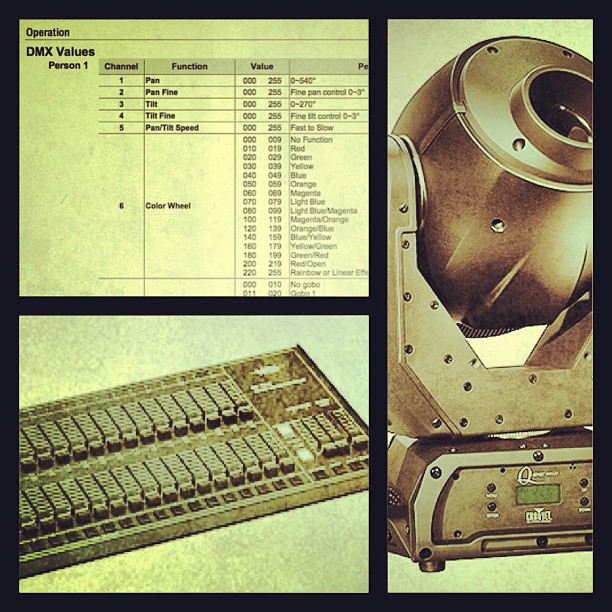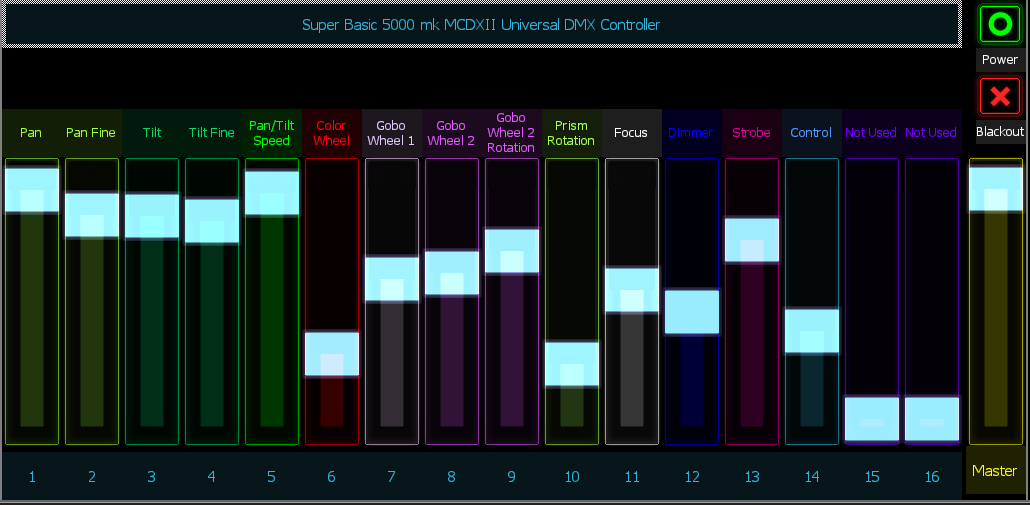Illuminating DMX: Part 3 B- DMX Protocol Charts vs Faders
 What Are We Trying to Accomplish?
What Are We Trying to Accomplish?
In my last blog we talked about DMX Protocol, or implementation charts. They're basically a list of parameters that can be controlled with a DMX controller. In this post we're going to look at how faders on a basic controller transfer to controlling parameters on a moving head light.
Something To Note:
I have forgotten to mention this important fact in previous posts. DMX transmits data in 256 steps, in numbers ranging from 0 to 255. So if your fader is all the way down at zero, you're sending number value 0 down that DMX channel. If your fader is at 100 %, all the way to the top, then you're transmitting number value 255. Certain parameters in a lighting instrument are looking for a specific value to perform a specific function. For example on a Chauvet Q-Spot 360, if you transmit between values 10 and 19 on channel 6, you tell the color wheel to rotate so that the light's output will be red. If you change that value to 47, the color wheel will turn to blue.
What Are We Using?
I initially thought about using a higher end instrument like a Robe Robin DLX Spot, and a Chauvet controller for our example. I thought about it, I decided to go with a more affordable lighting instrument that a band or small club might have. I also decided to go with a non-programmable controller that would still be fairly common. This wouldn't be the ideal situation at all, and we'll get to why eventually. Here's what we're using
Light:
I recently special ordered a Chauvet Q-Spot LED 360 (www.chauvetlighting.com) for a customer. They are using for a travelling trade-show booth.
Controller:
For our illustration, I'll use an "Super Basic 5000 mk MCDXII Universal DMX Controller." It's a completely made up 16 channel controller. They don't really exist but it was easy to draw in the software I use. I chose this because I can create a basic drawing with faders and label them. This will help you visualize how the faders will correlate to parameters on the light.
We'll pretend it's similar to aLeviton (Formerly NSI) N7016-D00 Console (www.leviton.com) because it is a fairly common console to find in houses of worship. It's a basic 32 channel DMX controller. You can either use it to control 32 channels, or control 16 channels and have two scenes. That's it. 32 channels of control. No programming. Two scenes. They were really designed to control dimmers, but today we're connecting a mover to it.
What Do We Need To Know?
I always recommend reading the manuals first. This will at least get you in the ball park on how to operate your gear. For our example we'll assume the manuals have been read. Let's take a look at our equipment.
- Our pretend 16-channel controller controls 16 DMX Channels. Since it's not a very fancy controller, there's no LCD Display to tell us what value we're transmitting on each DMX channel. The basic Leviton controllers work the same way.
- The Chauvey Q-Spot 360 can operate in two modes. On this instrument they're called personalities. Other manufacturers call them modes. It's important to note that we can run this in an 11 Channel mode or a 14 Channel personality (mode). This dictates how many DMX channels the instrument uses. (Manual Here.)
How Do We Do This?
- We'll need the DMX Protocol Chart for the Q-Spot. It's in the manual. We'll need to look at the 14-Ch personality.
- We need to connect the power cables, DMX cables and power things on.
- We need to properly address the Q-Spot. Since our controller only goes up to 16channels we have to stay under address 016. We also have to keep in mind that we're running the light in 14 channel mode, so, for example, if we address it at DMX Channel 013, then then we'll only be able to control 4 of the light's parameters. That means there's 10 things kinda hanging out there that we have no control over what so ever. For this example, we'll address the light at DMX address 001. That way fader one will control the first parameter, fader two will control the second parameter and so on.
The picture below shows our basic controller. Each fader is numbered, and labeled indicating what parameter of the Q-Spot it will control. Hope this helps!
~Andy

